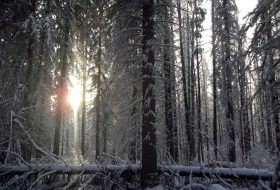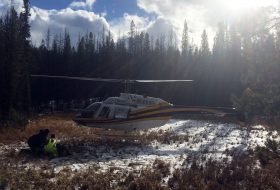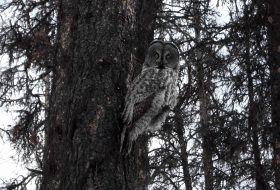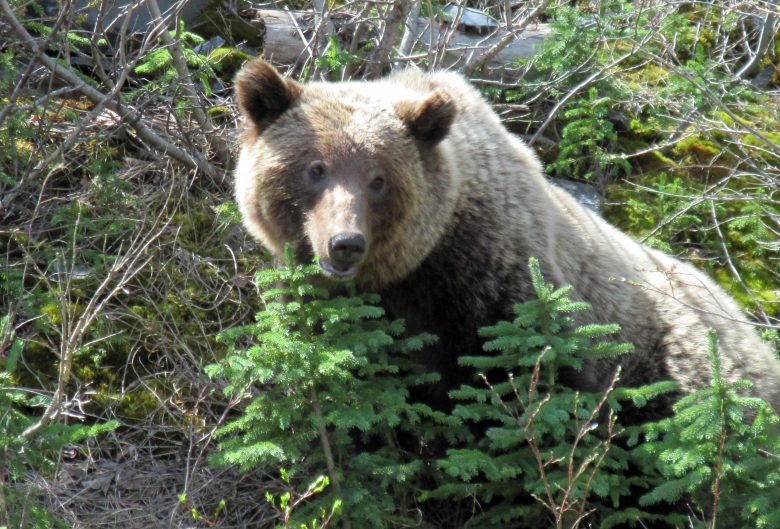In a previous blog I discussed the opportunities for forestry-related work in Prince George, ranging from planting trees to working in a sawmill; from forest engineering to timber supply analysis. In this blog I would like to pay tribute to an aspect of forestry that is quite familiar to me – the field work I get to carry out in the woods. Prince George is not only very close to the geographical centre of British Columbia, it’s also the centre of forestry for the entire interior region of BC, making it an ideal home for those seeking an exciting career in forestry field work.
Forestry is more than just cutting down trees

The sun breaks through a winter wonderland during a forestry field reconnaissance.
The word ‘forestry’ might give some people visions of large machinery mowing down trees with no apparent inclination towards the environment or anything that lives in it. In actuality, there’s a great deal of planning involved prior to a single tree ever getting cut down. Input is provided by government agencies, local communities, First Nations, trappers and guides, recreational groups, environmental groups, researchers, public advisory groups and many others to ensure important issues and concerns are being addressed during the planning process. When planning an area to harvest, things that are considered include wildlife habitat, fisheries habitat, First Nations traditional territories, archaeological sites, visual quality, terrain stability, water quality, to name just a few. Once all concerns are addressed, then the field work can start, and it is these forestry field workers that are the first people on the ground.
Heading into the woods to assess proposed harvesting areas

Forestry field workers crouch down as a helicopter picks them up at a remote location north of Prince George.
When assessing a proposed harvesting area on the ground, forestry workers will look for things that may have been missed during the planning phase. They will complete a reconnaissance of the area looking for incremental site-specific features that may need protecting. Such features may include natural springs, animal dens, and raptor nests, to name a few. They will ensure that important wildlife habitat, such as lichen sites favoured by caribou and well-travelled wildlife corridors, are cared for and protected. They have been trained in the identification of rare plant communities and the classification of fish-bearing streams, wetlands and lakes to ensure these features are appropriately managed for.
Figuring out which trees can be harvested

A great grey owl watches foresters intently from the safety of a tree.
Once all areas of concern have been properly managed for, what remains is the area that can be harvested. Forestry field workers mark the boundary of these areas, establish road networks, and ultimately develop a plan for harvesting. Included in this plan is how, when and where the timber will be harvested, and how the area will be returned to a productive forest once again, including instructions on the type of tree species that will be planted after harvesting is complete. Additionally, workers complete an analysis of the timber volume in the area, which will be used to calculate the overall economic viability of harvesting the area and the stumpage that is payable to the Province for the volume of timber removed.
Love being in the woods? Forestry might be the right career for you
There is a lot of information to grasp an understanding in during the process of becoming a good forestry field worker. Some of the disciplines touched upon include wildlife biology, fisheries biology, ecology, engineering, botany, archaeology and earth sciences. But one of the most important elements to being effective in this job is a love of nature and the outdoors, because you spend a lot of time in the woods.
Armed with a thirst for adventure, a love of the natural environment and a willingness to learn, people have flocked to Prince George for decades to become forestry field workers. And it’s these qualities that have enabled a countless number of them to forge productive and rewarding careers that have helped to shape Prince George into the wonderful city it is today.
If you’re interested in a career in forestry, check out the Forest Ecology and Management program at the University of Northern British Columbia.
Already have the education to work as a forester? Search for jobs on the Move Up Prince George Career Search page.
And don’t forget to join the conversation on Facebook and Twitter.




